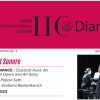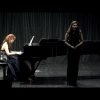Meche Kroop introduced this recital program by saying that she started this series of recitals spotlighting young classical singers from around the world performing their native music in response to the xenophobia, prejudice and fear of the “other” being promoted by governments around the world including our own. Meche feels that music is a healing and uniting force that counteracts hatred and prejudice. The recital (which was performed on February 28th at St. John’s Church in the Village) had each singer performing the native music of their homeland. Aza Sydykov was the musical director and pianist.
The recital began with soprano Maria Brea from Caracas, Venezuela singing six songs from her native country. Brea’s soprano is luscious, rich in overtones with a shimmering fast vibrato. The songs ranged widely in style from a simple folk lullaby sung a capella (“Duérmete mi niño”) to Latin American pop (“Arrunango”), zarzuela (“Alma llanera”), flamenco (“Quiero sembra”) and jazz cabaret (“La Negra Attilia”) styles.
I heard music that reminded me of Antônio Jobim, Astor Piazzolla and Heitor Villa-Lobos. Each song was strongly contrasted from the others. Brea wasn’t afraid to dig into chest voice or darken or lower her voice to create a different sound. Throughout this varied program, Brea displayed a distinctive beauty of timbre and projected her music with poise and command.
The bolero torch song “Desesperanza” by 20th century female Venezuelan composer Maria Luisa Escobar is the favorite song of both Maria’s father and her sister who sings it herself but in a different, more pop-inflected style. Maria brought a more classical timbre and a thrilling high note at the end that were very much her own. Hispanic music expert and musicologist Pablo Zinger accompanied Maria on the piano with great insight and stylistic command.
Delhi-born, New York trained mezzo-soprano Pallavi Seth sang two classical Indian songs – one semi-classical “Huri” and one classical bandish from “Raag Khamaj” both self-accompanied on Tanpura. Seth began singing classical Indian religious songs under the guidance of her guru and later studied as a Hindustani classical vocalist under the legendary Benares gharana singer Girija Devi. Vacations in the U.S. led to an interest in European classical music and study at Westminster Choir College and Mannes School of Music.
Seth performed the two songs seated on the stage with great spiritual insight and self-communion. The songs began with keening wordless vocalise and then the Hindi text was chanted. Both songs involved melismatic writing and keening high notes where Seth’s opera background became evident – there was a flexibility of tone and purity of attack that showed her operatic training. Seth believes in blending cultures and also performs songs by Adele and Amy Winehouse, sings with a progressive jazz rock band, has done American musical theater and loves Bollywood music. At age 26, Pallavi Seth is open to the entire world of music and eager to explore everything.
Paris-born French soprano Claire de Monteil has studied at AVA where she performed operatic roles like Leonora in Il Trovatore and the title role in Ariadne auf Naxos. This is a large, forward placed and deeply resonant soprano with a wide range of dynamics. Monteil did not program French opera which I would like to hear her in (the great falcon roles are something she would excel in). Nor did she explore the classical French song repertoire of Poulenc, Chausson or Massenet.
Instead for this recital, de Monteil turned to the French cabaret songs of German-born Kurt Weill and Hungarian-born Joseph Kosma. Operatically trained sopranos like Teresa Stratas have sung Weill’s German and French ballads with success as has rock singer Marianne Faithfull and the Italian pop singer Milva. All these singers are very different from Lotte Lenya, Weill’s wife and muse and all have made this music their own.
Her first song “Youkali” is a song about hope and a mythical place where all your dreams come true: “pays de nos désirs”. The text was projected with both clarity and specificity and the melody was shaped persuasively. The brilliant final climax was operatic. Weill’s “Je ne t’aime pas” is a tormented ballad about a conflicted lover who, as much as they are trying to convince themselves that they don’t want or love the object of their affections – repeating the title phrase over and over – cannot emotionally tear themselves away from this person. Monteil sang each repeat with a different expression and inflection as the protagonist wrestled with their feelings. It had the rawness of Piaf with the grandeur of Crespin!
The last song was the pop favorite “Les feuilles mortes” or “Autumn Leaves” by Kosma. Here I felt that de Monteil’s vocal scale and brilliance detracted a bit from the sense of intimacy and nostalgic reflection in the song – a softer grain to the tone and a darker color would have brought out the melancholy in the piece.
The first half ended with two short pieces by the Ghana West Africa-born bass Kofi Hayford. The two pieces were national anthems: the first the official one in English “God Bless Our Homeland Ghana” by Victor Gbeho and the second the unofficial folk anthem “Yen Ara Asaase Ni” by Ephraim Amu in the Akwapim Twi language (only one of eleven languages in Ghana!). It turns out that Victor Gbeho was Kofi’s great uncle!
The first was a grand scaled oration which got a new English sung text in the 1970’s. The second folk anthem which translates as “This is our native land” is a declamatory warning instructing the Ghana people not to lose their native values in emulation of European wealth and power but to respect their own heritage and customs. Hayford’s focused and resonant bass gave it the declamatory force of an operatic high priest or ruler! I have admired Hayford’s silken black bass in several performances by local opera groups.
The second half brought more Latin American music courtesy of Guayaquil, Ecuador-born tenor César Parreño who was also accompanied by Maestro Pablo Zinger (who Parreño confessed he had only met 30 minutes prior to performing! One never would have known!). Parreño, a Juilliard student, sang five Ecuadorian pasillos which are folk ballads usually sung to guitar accompaniment at parties or fiestas. The pieces had great variety ranging from “Despedida” a song of farewell by Gerardo Guevara (who studied in Paris with Nadia Boulanger) and the dashing “El Aguacate” a love ballad sung beneath the avocado tree of the title composed by César Guerro Tamayo. Parreño has a plangent, sweet lyric tenor with a bright timbre that bears a distinct resemblance to the lovely voices of Mexican tenors Javier Camarena and Ramon Vargas.
Armenian mezzo-soprano Alvard Mayilyan performed four songs in colorful native costume. Three of these songs were songs of love: “To Him” by Perperian – a passionate woman awaits her lover willing to give all of herself; “Hoy Nazan” by Komitas has two lovers meeting joyously and finally “Lullaby” by Kanachyan which is the love of mother and child where the two are one and the rest of the world does not exist. (Mayilyan is the mother of two and sings this to her own children).
The last song was the dance-like “Drinking Song” by the very famous composer Aram Khachaturian (best known for the ballet “Spartacus”). Khachaturian also wrote many songs and this was a catchy and colorful piece. Mayilyan’s voice has a warm vibrant color typical of Armenian voices resembling a rich sparkling red wine. Occasionally around register breaks the tone would go out of focus briefly – with each song this became less evident. Each song was vividly characterized and sung with passion.
Our final performer was tenor Dashuai Chen, a native of Shanghai China, with three Chinese songs in Mandarin. Chen was a 2019 winner of the Metropolitan Opera National Council Auditions. I was surprised how lyrical and non-Eastern sounding these three songs were – they sounded more Western in style and weren’t reminiscent of Chinese opera or folk music. “The Three Wishes of the Rose” by Zi Huang sounded more like a European art song in Mandarin. “Teach me how to forget him” by Yuanren Zhao was lyrical and full of melancholy longing and regret. The final piece “Love for the sea” by Guangnan Shi started as a reverie to nature but seemed to turn inward with sadness and then outward with an outpouring of passionate melody as if the protagonist’s love of the sea turned to thoughts of their beloved.
Chen possesses a major instrument: the first two songs were written low in the middle voice which misled me into thinking that Chen was a lyric baritone. However, the overwhelming climax of the third song had Chen pouring out high tessitura and a climactic high note that firmly announced his tenor status. Chen seems to have lots of voice everywhere. Initially in the first song, Chen seemed a little stiff and preoccupied but with each song he loosened up and revealed more of himself culminating in the overwhelming vocal and emotional outpouring of the final song. The final phrases of “Love for the Sea” could have come from the passionate final scene of an Italian verismo opera sung in Chinese translation!
I was impressed with how Maestro Aza Sydykov managed to learn all this unfamiliar music of widely disparate national styles and genres adapting so well to each singer’s different needs and methods.
Meche asked each singer to sing something that meant something to them – music that they had a personal connection with. Too often in recitals the encores outshine the main program. Usually (and especially in student recitals), the recitalist performs European classical music from a distant culture and time period that is foreign to their culture that they have been carefully coached in. So, the recital has the feeling of a lesson well learned and dutifully executed without personal engagement or identification.
The encores include pieces that the singer chooses themselves, often popular songs in their own language. Suddenly, the performer’s own personality and temperament shines through and they relax and connect with the piece and through the piece connect with the audience. That was what we saw with this recital – each singer had probably heard or performed this music as a child or student in their home country. Perhaps they first sang these songs with their families or at school concerts discovering music and their own joy of singing. The words are in their language and reflect their sense of self. Nothing here was dutiful or by rote and each singer projected a very distinctive and highly developed individuality of sound, interpretation and communication. They connected with the music and through the music connected with us – and we connected to them and to cultures from around the world through a shared love of music.







